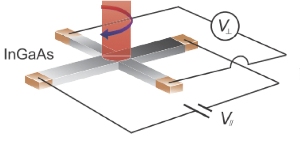A highly efficient spin-charge converter has been created by a group of researchers at Institute of Physics at Johannes Gutenberg University Mainz (JGU) using gallium-arsenide (GaAs), a common semiconductor material.
 Tunable spin Hall angle device based on GaAs through field induced intervalley repopulation (©: Jairo Sinova)
Tunable spin Hall angle device based on GaAs through field induced intervalley repopulation (©: Jairo Sinova)
Spin-charge converters are devices which allow electrical signals to be converted into magnetic ones, and vice versa. They differ from conventional electronic devices in that they make use of the spin and spin related-magnetism of electrons, as well as the charge of electrons.
The gallium-arsenide-based spin-charge converter created by the team at JGU delivers efficiencies which are comparable to that of the heavy metal, platinum.
The research team at JGU, led by Professor Jairo Sinova, theoretically demonstrated the underlying mechanism of the spin-charge converter, paving the way for innovative spintronic materials to be developed. According to the researchers, the accurate alignment, transmission and detection of an electron’s spin are crucial and can be achieved using electric fields instead of magnetic fields.
This allows charge manipulation mechanisms, which are well known in semiconductor electronics, to be applied to the field of spintronics, allowing magnetism to be integrated into semiconductor physics.
It is essential to have spin-charge converters which are capable of converting spin currents into charge currents and vice versa. The spin Hall effect is the phenomenon behind the spin-charge converters and occurs when electrons are driven by an electric field through a semi-conductor plate.
To induce the spin Hall effect, circularly polarised light is used to irradiate the sample to generate the electron spins, which are either parallel or anti-parallel and perpendicular the direction of movement and the plate.
Based on the orientation of the spin, the moving electron spins are driven towards any one of the sides of the plate by spin-orbit coupling which is a relativistic electromagnetic phenomenon. This results in the separation of both spin orientations.
The gallium-arsenide-based spin-charge converter delivers superior efficiency even at ambient temperature, which is crucial in real-world applications. The researchers also demonstrated the possibility of changing the efficiency of the spin-charge converter by distributing the electron spins on different lanes through the application of varying electric field.
The results have recently been published in Nature Materials.